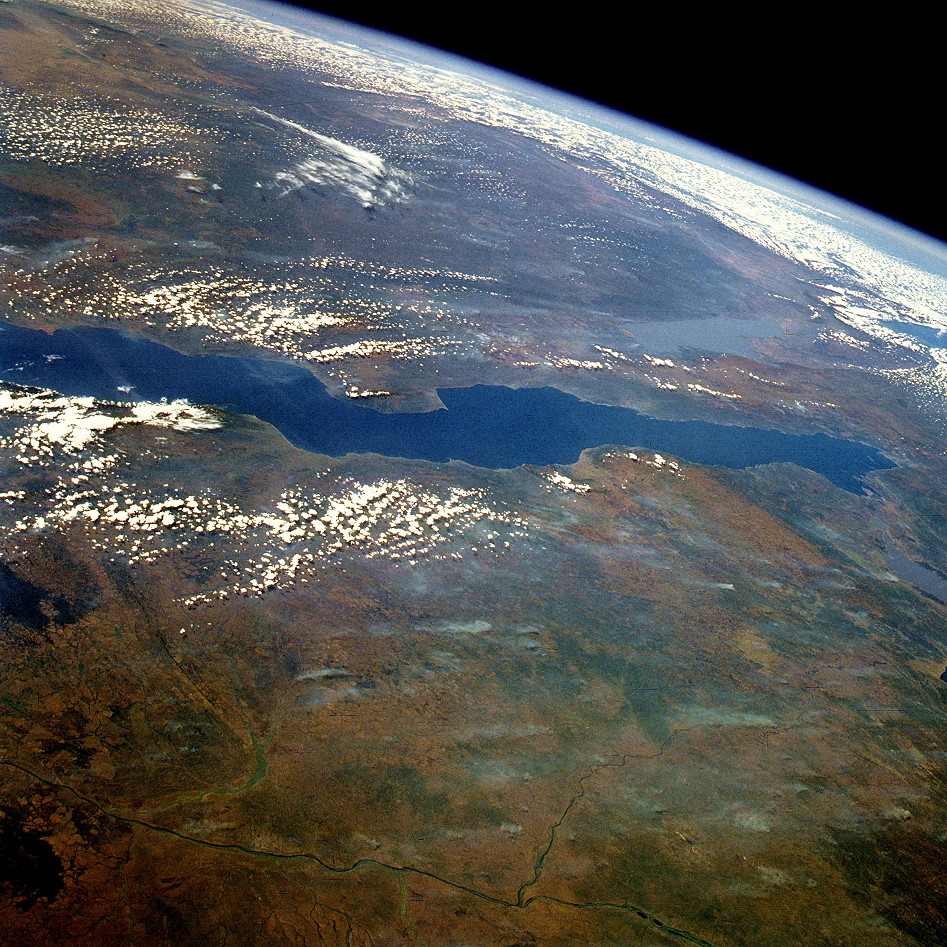
Three decades ago, on 17 June 1985, the seven-strong crew of the 18th shuttle mission rocketed into orbit with a cargo of three commercial communications satellites, a free-flying astronomical observatory, the oldest woman yet to travel into space, and representatives of no fewer than three discrete nations—the United States, France, and Saudi Arabia—packed aboard Discovery. Mission 51G was the fourth of nine shuttle flights which would be undertaken in 1985, the year preceding the calamitous loss of Challenger, and it marked the high-watermark of a time in which the reusable fleet of orbiters were in the midst of a “Golden Age” of dazzling achievements.
So confident was NASA in the shuttle’s capabilities that it had already agreed to fly U.S. politicians and foreign nationals aboard missions as “payload specialists.” If a customer’s satellite or experiment filled more than a certain amount of the orbiter’s payload bay, an accompanying seat for a human representative was offered. Mission 51G carried the French Echocardiograph Experiment (FEE) and an Arabsat communications satellite, so it came as little surprise that Frenchman Patrick Baudry and Saudi Arabian Sultan bin Salman bin Abdul-Aziz Al-Saud were aboard as payload specialists. As a member of the Saudi ruling family, Al-Saud thus became the first person of royal stock ever to journey into space. Within NASA’s astronaut corps, opinions were strong and some cynically labeled 51G as “The Frog and Prince Flight.”
Others had already picked fun at the “training” of Republican Senator Jake Garn, who flew aboard an earlier mission, by posting a sign-up sheet on the astronaut office bulletin board, calling for volunteers to take an eight-week course to become a fully-fledged senator! Their fury was not misplaced; the professional astronauts had paid their dues to take shuttle seats through brutal tours of Vietnam, ferocious workloads at test pilot school, and years of academic study. With the Republican Garn having flown, a Democrat—Florida Congressman Bill Nelson—was the next politician due to fly, and NASA was already soliciting applications for its Teacher in Space and Journalist in Space programs. “This was an unhealthy environment,” admitted astronaut John Fabian in a NASA oral history. “We were taking risks that we shouldn’t have been taking. We were shoving people onto the crews, late in the process, so they were never fully integrated into the operation of the shuttle, and there was a mentality that we were simply filling another 747 with people and having it take off from Chicago to Los Angeles. This was not that kind of vehicle, but that’s the way it was being treated at that time.”
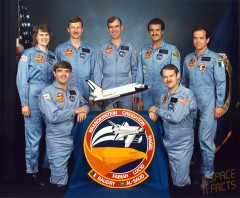
Of course, that is not to suppose that the two payload specialists on 51G were unqualified. Baudry, a lieutenant-colonel and former fighter pilot in the French Air Force, had a long relationship with the space program, having backed-up fellow Frenchman Jean-Loup Chrétien on a flight with the Soviet Union. (In fact, for 51G, the two men remained together and exchanged roles, with Chrétien backing-up Baudry.) Baudry’s first exposure to space came in June 1980, when he and Chrétien were selected by the Centre National d’Études Spatiales (CNES, the French national space agency) as candidates for a joint Franco-Soviet mission to the Salyut 7 station. This mission, Soyuz T-6, took place in June 1982, and a little more than two years later the Baudry-Chrétien team were sent to NASA by CNES for a shuttle flight involving the French echocardiograph. Initially, they were attached to Dan Brandenstein’s 51D mission, originally scheduled for March 1985, but the delays to the shuttle fleet in the spring of that year pushed them further into the summer and they were reassigned to 51G in June.
As for the Saudis, the responsibility of their payload specialist was to “observe” the deployment of Arabsat-1B, a powerful communications satellite to be deployed atop a Payload Assist Module (PAM)-D booster. The Arab Satellite Communication Organisation had been established in 1976 by members of the Arab League to serve the telecommunications, information, culture and education sectors, and its first satellite, Arabsat-1A, was blasted into geostationary orbit in February 1985. Unfortunately, one of its solar panels failed to extend correctly and, coupled with other problems, it was relegated to a “backup” status until 1991, when it was finally abandoned.
It was therefore with high hopes and much fanfare that the second of three planned Arabsats was loaded aboard Discovery. Built by a French-led international team, including Aerospatiale and Messerschmitt-Bölkow-Blohm (MBB), and based on the cube-shaped Spacebus-100 platform, Arabsat weighed around 1,540 pounds (700 kg) at launch. Electrical power for the satellite came from two rectangular solar “wings,” which spanned 69 feet (21 meters) and yielded 1.4 kilowatts. It had a pair of S-band transponders and 25 C-band transponders. Attitude control was by a low-thrust motor, fed by a volatile mixture of hydrazine and nitrogen tetroxide.
Yet, according to John Fabian, who flew aboard 51G, Arabsat-1B had failed all of its pre-flight safety reviews. “The crew recommended that it not be flown,” he told the NASA oral historian, “the flight controllers recommended that it not be flown and the Safety Office recommended that it not be flown, but NASA management decided to fly it.” The political embarrassment, not to mention the commercial impact for missions further downstream, was simply too much to bear. (In fact, Fabian would later reveal that NASA’s growing laxity in flight safety prompted his departure from the agency.) Shortly before Arabsat-1B was released, telemetry indicated that one of its solar arrays had prematurely unfurled; it was a false reading, thankfully, and turned out to be nothing more than a problem with a microswitch, but required the crew to do an inspection with the camera on the shuttle’s Remote Manipulator System (RMS) mechanical arm. …
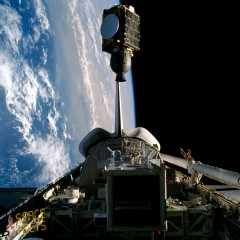
The two payload specialist candidates chosen to oversee the Arabsat-1B deployment were announced in April 1985, just two months before launch: Al-Saud was the first member of royalty to be considered for a seat on a space mission, whilst his backup, Abdulmohsen Hamad Al-Bassam, was a fighter pilot in the Royal Saudi Air Force. Al-Bassam must have worked very much in Al-Saud’s shadow. It was the first time Al-Bassam had ever met anybody from the royal family, according to 51G pilot John Creighton, and the entire crew was impressed by the entourage surrounding the prince when he arrived in Houston. “It was obvious to all of us,” Creighton chuckled, “that Prince Sultan had grown up in different financial circles than the rest of the crew!” Born in June 1956, the son of the governor of Riyadh and a nephew of King Fahd, he was also just 28 years old, making him the youngest person ever to fly aboard a U.S. spacecraft. It is a record which he retains to this day.
At first glance, it would appear that the choice of a member of royalty as the first Saudi spacefarer was little more than an outrageous example of nepotism. Indeed, this very fear had crossed King Fahd’s mind when Al-Saud was first proposed as a candidate. The King turned him down, flat. He would not allow his nephew to fly in space. “I was really disappointed,” Al-Saud told an interviewer from the Smithsonian. “Even if there was only a 10 percent chance I’d get to do it, I wanted at least to go through the process. I asked my father to ask again and the King was still hesitant. He thought there might be talk about how the Royal Family had just pushed in their own guy. I appreciated that, but I explained that this was not going to be Saudi Arabia’s choice. I wanted to be put to the test by my own merit, so he approved.” For the NASA astronauts, having someone of a profoundly different culture—and religion—aboard their mission posed some challenges. Commander Dan Brandenstein was keen for Al-Saud to feel welcome. The Arab-American Oil Company (ARAMCO) had offices in Houston, Texas, and Brandenstein called a team from their human resources department to give the remainder of his crew an introduction to Saudi customs. He had few concerns about Baudry; he was French and a fighter pilot, and as such they spoke similar languages. But Al-Saud was an unknown quantity.
“They were worried for a while about somebody making a statement for Allah and doing something dumb up there,” John Creighton told the NASA oral historian, “so they gave him a psychological profile. They did the same thing to all of us, too. It’s a part of the astronaut selection process. The psychiatrist came back and said: ‘He’s saner than most of the rest of the astronauts!'” Aside from the religious issue, Brandenstein did not want to make any cultural missteps. “Don’t tell any harem jokes,” Brandenstein told his crew, “or any camel jokes.” Very soon, he realized that he need not have worried, for Al-Saud had spent much of his adult life in the United States. At his first meeting with the crew, the prince introduced himself with a self-deprecating joke: “I’ve left my camel outside!” The tension and the ice were immediately broken. “In fact,” Brandenstein told the NASA oral historian, “he was more attuned to the American way than the Frenchman was. A lot of times we’d [tell] … a subtle-type joke that the Frenchman didn’t understand and the Sultan would lean over and explain it to him!”
Sultan, as he came to be known by the crew, received elementary schooling in Saudi Arabia, then travelled to the United States to study for a degree in mass communications at the University of Denver and a master’s in social and political science from the Maxwell School of Syracuse University. Whilst there, he also qualified for his private pilot’s license. Back home in 1982, he became a researcher in the Department of International Communications at Saudi Arabia’s Ministry of Information and, two years later, was deputy head of his country’s Olympic Information Committee. Immediately prior to commencing 51G training he was acting director of the Ministry of Information’s new department of advertising.
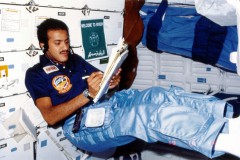
When the contract was signed with NASA to launch Arabsat-1B aboard the shuttle, Saudi Arabia won the payload specialist seat from amongst the 22 members of the Arab League and 20 candidates were chosen, all qualified pilots, all in exceptionally good health and all capable of speaking fluent English. Al-Saud and Al-Bassam arrived in Houston in April 1985 and received 114 hours of “habitability” training, learning to adapt to the routines of living aboard the shuttle. Although the national Saudi dress—the flowing thwb and ghutra—were inappropriate, Al-Saud was permitted to carry traditional foods with him, including dates from Medina. Both men also trained for a number of Saudi experiments, including one provided by one of Al-Saud’s relatives, Prince Turki bin Saud bin Muhammad Al-Saud. The experiment was part of his PhD dissertation at Stanford University and used TV and still cameras to measure the chemical composition of rocket-exhaust gases and their interaction with the ionosphere. Another investigation was devoted to remote sensing of Saudi Arabia itself, as part of efforts to develop new groundwater exploration programs, further research into sand movement, and better define areas of substantial mineral deposits within the kingdom. Al-Saud’s final experiment observed the behavior of water-oil mixtures in microgravity—with samples of Kuwaiti, Algerian, and Saudi oil diplomatically chosen for the task. All three investigations were conducted under the auspices of the Arabsat Scientific Experiments Team, led by Abdallah Dabbagh, head of the Research Institute of the University of Petroleum and Minerals in Dhahran.
One other “experiment,” which caused more than a few raised eyebrows, was labeled simply Lunar Crescent Observation or “LCO.” It was mentioned in the 51G press kit as an attempt “to observe the crescent of the new Moon with the unaided eye from orbiter windows as it becomes visible close to the western horizon” and would occur on either 17 or 18 June 1985. At first glance, this sounded innocuous enough; a request to observe the new Moon. It wasn’t. “The LCO was actually religious in nature,” wrote astronaut Mike Mullane in his 2006 memoir, Riding Rockets. “The mission was going to occur in the ninth month of the Muslim calendar, the fast of Ramadan. This period of fasting and spiritual contemplation ended at the sighting of the new crescent Moon. Prince Al-Saud just wanted to be a space observer to the end of the fast of Ramadan.”
It would seem from Mullane’s account that NASA approved the LCO task without realizing that it was a religious observation and when Dan Brandenstein found out the truth he was concerned that Al-Saud would be using an American spacecraft as an orbital minaret. “Knowing that he would be at the center of a shit-storm,” continued Mullane, “Brandenstein confronted the prince and made him agree on the exact wording he would use if he discussed the Moon observation on the air-to-ground link, wording devoid of anything religious.” As 51G’s commander, Brandenstein had enough to worry about with ensuring that his crew completed their mission objectives, without having the added distraction of worrying about what one of the payload specialists might say over the radio. With his flight into space, Al-Saud thus became the first Muslim in space and the first to witness the new Moon from above the atmosphere. Two hundred and thirty Saudi VIPs were at the Kennedy Space Center for the launch, including 29 princes. The mission drew much attention in his homeland, some of it demonstrative of the archaic attitudes and principles still prevalent there.
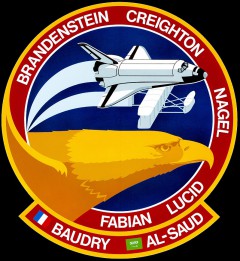
Mike Mullane served as one of the capcoms in Mission Control during 51G and remembered being given a note at one stage of the flight by a Public Affairs official. Amongst the crew was Shannon Lucid, who had been seen on several occasions in shorts as she moved around the orbiter’s cabin. The note requested that the entire crew should wear trousers, not shorts, during a forthcoming press conference. “When the note came to me, I understood its intent,” wrote Mullane. “Public Affairs was concerned that the Arab world might find it offensive for one of their princes to be seen hovering in mid-air with a woman’s naked legs prominently displayed next to him.” Mullane threw the note in the bin. In his mind, he was not prepared to tell an American woman, on an American spacecraft, to modify her dress “to accommodate the values of a medieval, repressive society, where women couldn’t drive cars, let alone fly space shuttles.”
Despite his concern about the nature of the LCO experiment, Dan Brandenstein had no intention to call for its removal or cancellation—partly because of the possible effect on his career, but also perhaps due to the fact that his mission had changed beyond recognition from the flight to which he, Creighton and mission specialists John Fabian, Steve Nagel, and Shannon Lucid had been assigned, way back in November 1983. Originally designated “Mission 51A,” they were to have been launched in October 1984, deployed Canada’s Anik-D2 satellite and operated a payload known as the Materials Science Laboratory installed on a cross-bay structure, together with experiments in a “bridge” of Getaway Special (GAS) canisters. By August 1984, the flight had changed significantly; redesigned 51D, it was to fly in March 1985 and deploy the U.S. Navy’s Syncom 4-3 communications satellite and retrieve NASA’s Long Duration Exposure Facility (LDEF), which added a rendezvous commitment to the training regime. They also acquired McDonnell Douglas engineer Charlie Walker and Hughes engineer Greg Jarvis as payload specialists, becoming a crew of seven. This mission was itself scrubbed only three weeks before its scheduled 19 March 1985 liftoff, when the cancellation of Mission 51E disrupted the entire shuttle schedule. “We did our pre-flight press conference about the LDEF,” Steve Nagel recalled, “walked back to the astronaut office … and we didn’t have a flight anymore. It was gone!”
Instead, Brandenstein’s crew gained Arabsat-1B, Telstar-3D, Mexico’s Morelos-A, received Patrick Baudry as a “new” payload specialist and inherited the Shuttle-Pointed Autonomous Research Tool for Astronomy (SPARTAN). This free-flying astronomical observatory was originally scheduled to make its first flight on Mission 41F in August 1984, but was extensively delayed. Brandenstein’s mission was redesignated “51G” and rescheduled for a 17 June 1985 liftoff. Charlie Walker was moved off the crew, since his company’s electrophoresis experiment had already been loaded onto the middeck for another flight and it made greater sense to fly him aboard the other mission. He was replaced by Al-Saud, whilst Greg Jarvis was moved to a later flight and his place on 51G taken by Baudry. The crew and the payloads were thus in place for a key mission which would truly showcase almost all of the shuttle’s capabilities.
The second part of this article will appear tomorrow.
Want to keep up-to-date with all things space? Be sure to “Like” AmericaSpace on Facebook and follow us on Twitter: @AmericaSpace




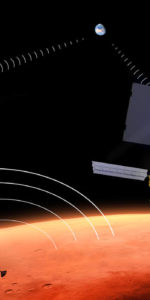
As much as I enjoy these historical articles, I do wish they could be done without all the foreshadowing of the Challenger accident. We’re all aware of the tragic and massive impact it had on America, the shuttle program, and spaceflight in general, but it almost feels like a single pre-51L mission can’t be discussed without it coming up. Not trying to criticize, just wishing it didn’t *always* need mentioning.
Alex,
Many thanks for your comment, which was greatly appreciated. However, I do not believe this article overly emphasised the events of the Challenger disaster, other than mentioning them as a means of placing STS-51G into its proper context. It is important to reflect that 51G, together with the culture of “passenger” payload specialists and the Arabsat 1B problems, was an indicator of the prevailing attitude at the time that shuttle missions were “routine”, when in fact the opposite was the case. These were issues which later emerged in the Rogers investigation and, as such, are pertinent.
Many thanks again for your comment.
Ben
The Challenger and Columbia should always be mentioned- their losses define the shuttle program.